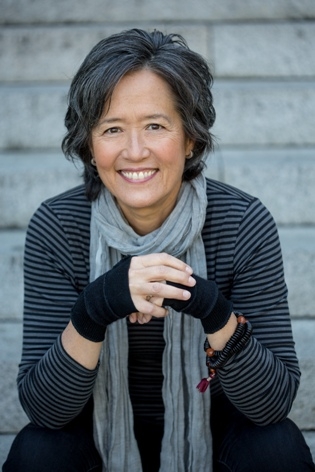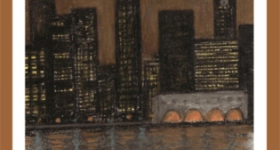I’ll just be upfront about it: I really
can’t do this book justice. Ruth Ozeki’s A
Tale for the Time Being makes you question your experiences as a reader, as
a person on this earth, and as a being in time and space. It’s ambitious, it’s
multilayered, and it’s fantastic.
I was introduced to Ruth Ozeki through
the anthology Charlie Chan Is Dead 2
and after reading her two previous books, what struck me was Ozeki’s ability to
insert humor and heart even into weighty subjects. In My Year of Meats, she exposes the ugliness of the meat industry
with an Eric Schlosser-like sense of outrage. And in All Over Creation, she harangues big Agribusiness. It’s been ten
years since her last book was published and in the interim, Ozeki has been deeply
immersed in Zen Buddhism. The result of her study is A Tale for the Time Being, a meta-fiction immersed in Buddhist
themes of impermanence, the interconnectivity of all beings, and being in the
now. But even with profound philosophical themes, she manages to keep her
signature biting humor.
Nao is a Japanese teenager living in
Tokyo who spends her days in cafes where the waitresses dress as French maids.
She wonders with sick fascination which googly-eyed pervert with a schoolgirl
fetish might get the courage to kidnap her. The French maid fad is dying down
so Nao always has a table to herself to frantically write in her secret diary,
which is a book of blank pages crafted from an old hardcover copy of Marcel
Proust’s À la Recherche du Temps Perdu
or In Search of Lost Time. After a
year of relentless bullying from her classmates, Nao has decided to escape from
the torment and “drop out of time” by committing suicide. Before she does, however,
Nao wants to chronicle the life of her great-grandmother, Old Jiko, the “famous
anarchist-feminist-novelist-turned Buddhist-nun of the Taisho era.” As Nao
recounts her classmates’ harassment, her father’s continuing spiral into
depression, and her loneliness, she also talks about how her parents send her
away to recover in the tiny remote temple in the mountains of Miyagi prefecture
where Old Jiko lives. But this is no Karate Kid story where Miyagi solves
everything. Despite Old Jiko’s wisdom, Nao still plans on ending her life.

Photo of the Author by Kris Krug
A second storyline interspersed between chapters
of Nao’s first person narration is Ruth’s story. She is a novelist living on a
remote island in British Columbia who stumbles upon a Hello Kitty lunch box
washed up on the beach. Inside are a pack of letters dated 1944 and ’45 written
in French and Nao’s undated diary written in English. As Ruth begins reading
Nao’s diary, she attempts to piece together a timeline and questions start to
emerge. Is the lunchbox detritus from the 2011 tsunami? Was Jiko’s temple
washed away? Is Nao still alive? Was she affected by the notorious Fukushima
nuclear reactor leak? And why does the diary make no reference to the letters
written in French? Every time Ruth manages to grab onto fragments of new information,
the answers keep eluding her. Even the diary’s last 20 pages, which she swears
were filled before, are blank.
Ruth believes that the events of the
diary are unfolding in current time, and that she still has a chance -- and therefore a duty -- to keep Nao
from committing suicide. In an attempt
to alleviate her feeling of responsibility towards Nao, Ruth’s husband reminds
her that the diary could have been written months or even years ago. Her
resolve to save Nao is similar to what readers in general feel towards
characters they feel deeply for. We feel accountable when we become so absorbed,
like cautioning movie characters of the threat of what’s behind the door because to us, the watchers, the story
is still unfolding. Characters remain in suspended animation, in their
age, place, and circumstances, until the reader reads on. It is Ruth’s search
for Nao that makes her question what is happening to her now. On her blog,
Ozeki says “Research in neuroscience has demonstrated that the brain registers
experience a moment after it occurs, so by the time it occurs to
us that we’re experiencing something, it’s already over. Life, as we think
we’re living it, is always a dream. It’s always an illusion.”
As the story unfolded and as I read on,
I started to feel that time, which was so certain and concrete, began losing
its edges. While I was reading this book, I found myself marveling at losing
entire chunks of mornings, afternoons, and evenings while immersed in the book
and even though I wanted to rush to the end, Ozeki doesn’t grant you permission
to hurry. Ozeki has always been adept at creating characters that are realistic
and likeable, and I sympathized with Ruth because I wanted to uncover the
answers to the mystery just as much as she did. Similar to Ruth, when we think
we get close to the answers, they start to slip away and reality and fantasy
start becoming blurred.
Ruth Ozeki creates multiple worlds that are
alive and filled with so much sensory details and symbolism and it’s difficult not
to resist being completely immersed. Stock your fridge, finish the laundry, and
feed the cat because you’ll be busy for a few days.
Jenny
Yap writes short stories and creative non-fiction and
is a lecturer in the English Department at California State University, East
Bay. She predicts this will be her favorite book this year but welcomes any
other recommendations.









Comments